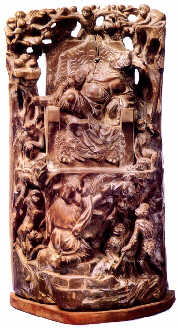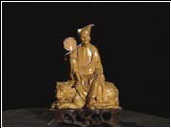Introduction

With a time-honored history, woodcarving boasts a great amount of genres with a variety of shapes. Historical records show that woodcarving came into existence as early as the Shang Dynasty(circa 1600-1100BC). Lu Ban, who is honored as the founding father of carpentry, was said to have carved a wooden bird, which was able to fly in the sky for three days during the Spring and Autumn Period(770-476BC).
Up to the Tang Dynasty(618-907), woodcarving art experienced remarkable development, at least partly because of the prevailing of puppet opera that boosted the craftsmanship of carving skills.
In the past, woodcarvings were mostly used in Buddha statues or figures, temple decorations as well as other construction decorations, dragon lanterns, steles, folding screens and other furniture. With several generations of efforts by artists, the function of woodcarvings has become more artistic. Generally speaking, woodcarving can be categorized into three genres concerning the method: circular, relief and pierced (hollowed-out) carving.

Boxwood carving, which has a history of about 900 years, is basically a kind of circular carving. Boxwood, the material, has a creamy and yellowish color, which darkens over time, giving an elegant and classic sense of aesthetic feeling. Boxwood carvings are mostly produced in Wenzhou and Leqing of East China's Zhejiang Province, as well as Shanghai Municipality and Southeast China's Fujian Province.
Based on traditional carving skills, the Shanghai boxwood carving assimilates western carving methods like dissection, inverse proportion, configuration, center of gravity and line. The works are mostly based from childhood stories and folk customs.

Making boxwood carving
The main artistic feature of boxwood carving is that all the works are made based on their original shapes, maximizing the use of the wood. Though there are many methods, the most prominent and popular way is circular carving.
The tools involved in woodcarving include a mud hammer, sculpting shelf, clay sculpture box, caliper (a kind of measurement tool), and scraper, as well as various kinds of knives. The tools used to shape the rough base include a saw, wood hammer and steel hammer, while the tools for carving are mainly chisels in various shapes like broad, flat and groove chisels.
The making process generally involves a couple of detailed procedures. First a sketch has to be made. Then the artist has to in succession sculpt the clay model, select fine wood, carve and then polish the wood, carve the grains, wax, and arrange the base. To produce boxwood carving of good quality, each of these complicated procedures has to be done very carefully.

Although usually more than one person creates the woodcarvings via a flow process, for some of the special works, only one artist completes them from the beginning to the end. Some adept artists do not need to sculpt the clay model, and rather can carve directly on the boxwood.










